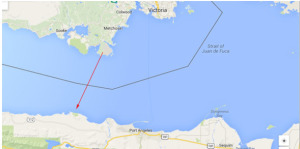Every year, from late September to early October, the southbound Turkey Vulture migration from Vancouver Island to the Olympic Peninsula is a dramatic sight when hundreds of birds make the 12-mile flight across the Strait of Juan de Fuca.
Observing from my back porch at Observatory Point (between Salt Creek and Freshwater Bay), this event can seem a bit like a Hitchcock movie as scores of black figures approach the shoreline, then soar low just above the tree lines toward inland destinations with the rhythmic swoosh-swoosh of their expansive wings as they pass overhead. Others stop to rest, perching themselves in the tall cedars on the coastal bluff where they bask in the sun.
The Turkey Vulture is a large, predominantly blackish-brown bird with a wingspan of 5-6 feet. The featherless red heads of the adults are rarely seen in flight, but are quite noticeable in perching positions. They are soaring birds, flying with their wings tilted up and exhibiting a unique rocking pattern that distinguishes them from other large birds in the region, most notably the Bald eagle.

This species’ migration is one of the most impressive in North America. The birds spend the summer months nesting predominantly on Vancouver Island and along Canada’s Sunshine Coast. In September, they gradually move toward the southeastern tip of the island—Rocky Point—where they wait for ideal conditions to cross the Strait. Ideally, the birds look for warm, sunny conditions and then cross during mid-day. Warmer days enable them to soar on thermals generated by solar heating. Turkey Vultures often begin their crossing by climbing several thousand feet, then gliding toward the Washington shore while they lose altitude.
Some years, the migration may take place in one or two days; other years, depending on weather conditions, the event may be spread out over several days.

